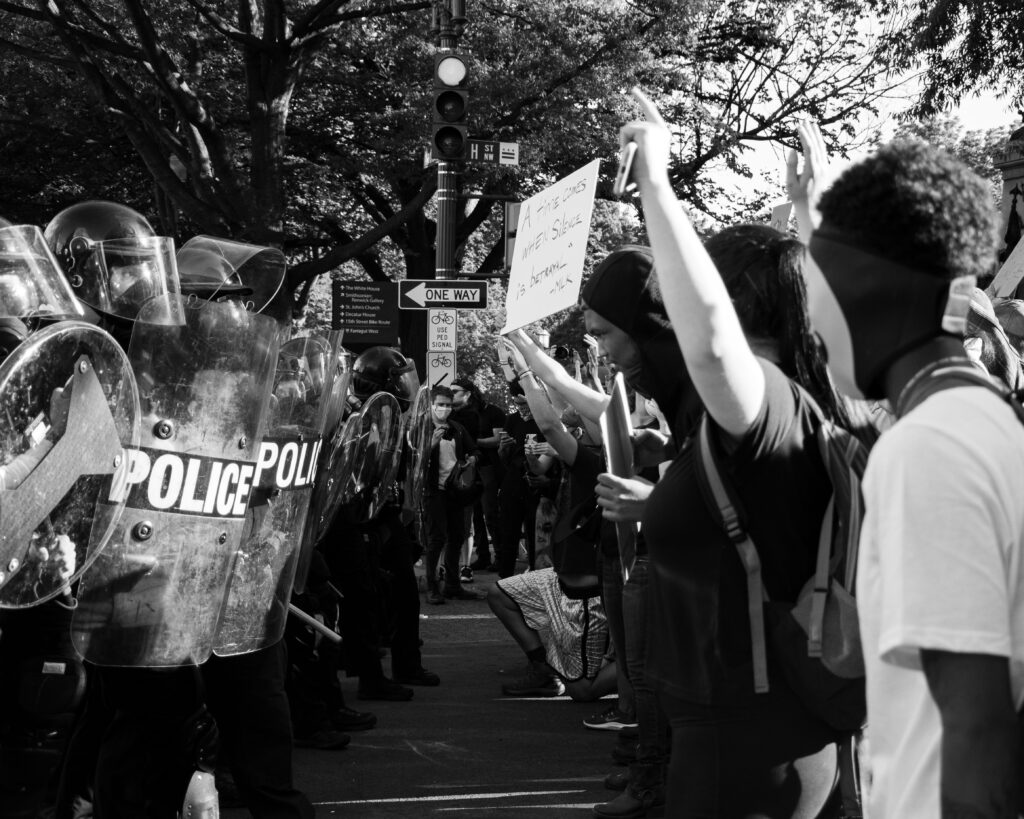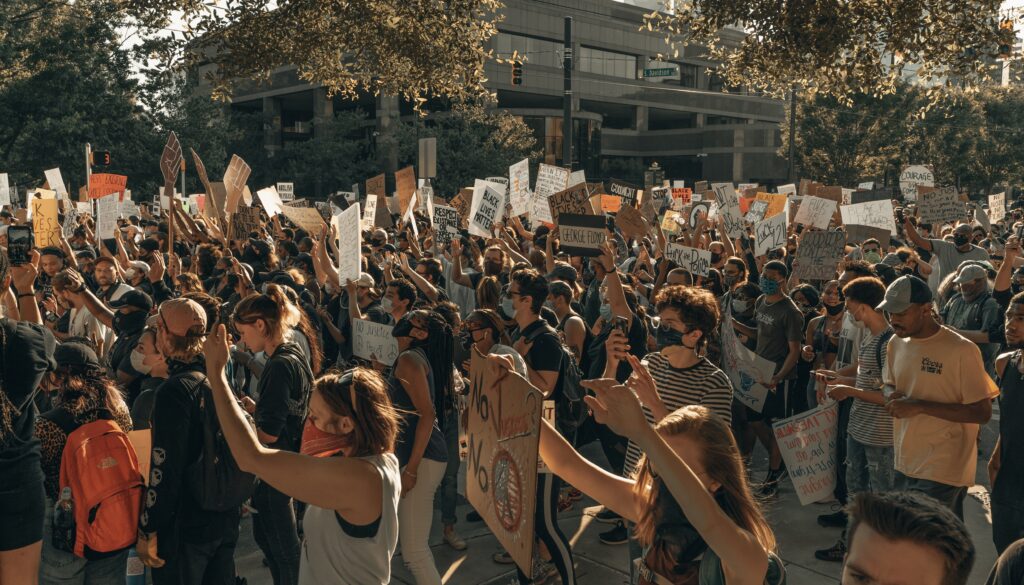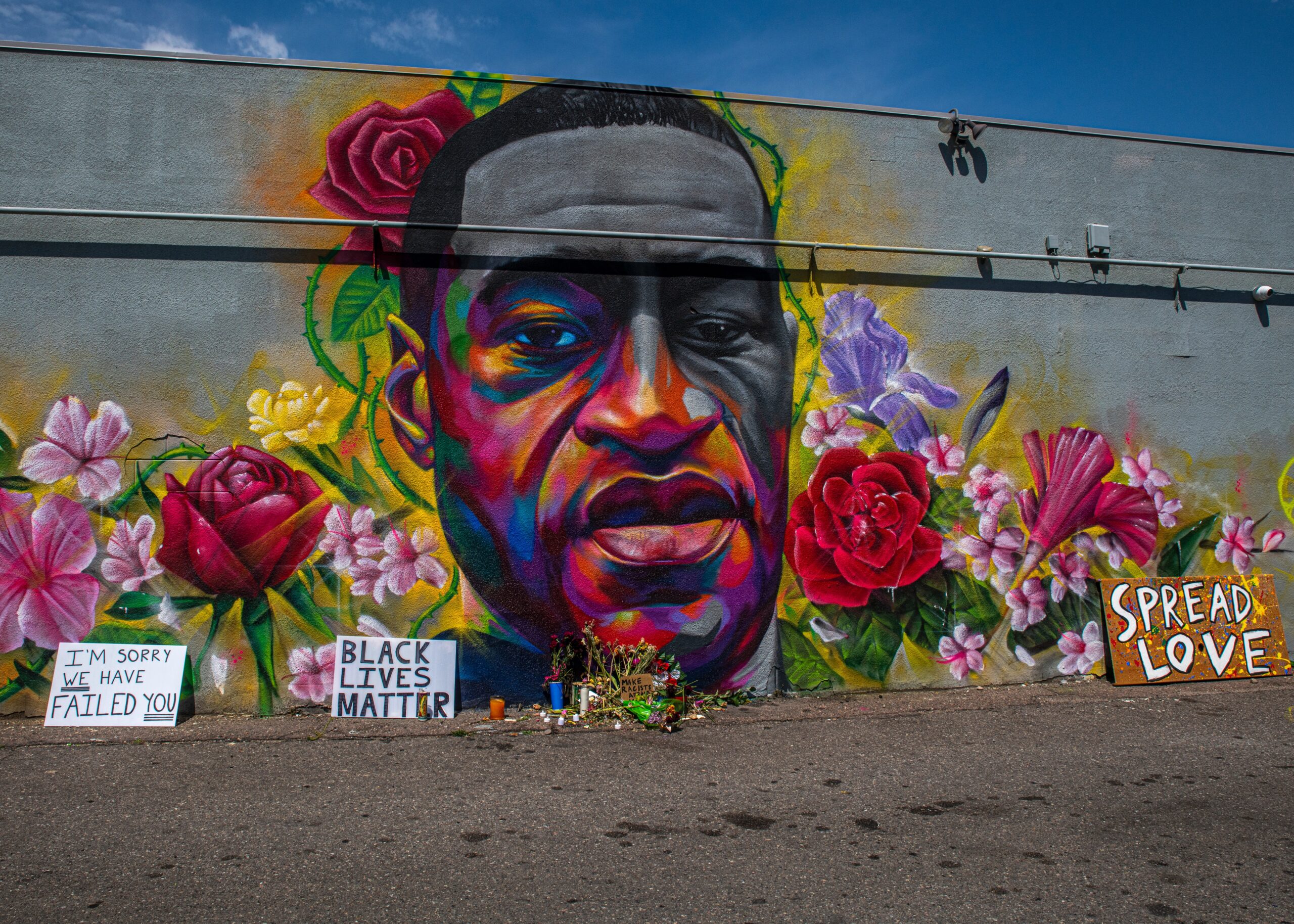How Freelance Journalists Worked Together To Recover From The 2020 Protests
Despite the impact protest reporting has had on them, these journalists stand by their decision to continuously report from the frontlines.
Like dozens of other freelance journalists, Melanie Buer was reporting on protests for racial justice throughout the summer of 2020. One hot Midwestern evening on July 25, around 150-200 protestors marched through the streets of Omaha, Nebraska, with Buer in tow covering the event. In the months after George Floyd was killed in May 2020 by Minneapolis police officer Derek Chauvin, protests popped up around the country as millions took the streets with demands for justice and police abolition. By July, the crowds of thousands had dwindled, but the police violence never stopped.
That night in Omaha, protesters chanted, and carried signs demanding justice for George Floyd; Breonna Taylor, who was shot and killed in her home in March 2020 by police in Louisville, Kentucky; and James Scurlock, a 22-year-old Black Nebraskan who was shot to death by a white bar owner during a Black Lives Matter protest just five days after Floyd was murdered. The action was also a solidarity rally with protestors in Portland, Oregon who had been victimized by an increasingly militarized federal police force. The scene in Omaha was mirrored all over the country, albeit with different names, different signs, and different journalists snapping photos and conducting interviews, as police looked on in riot gear and with military-grade weapons ready to suppress the largest protest movement in US history. That night, Buer followed the protesters across an interstate overpass as the march came to an end. The activists were getting ready to leave the protest after a night of marching and chanting, when police in riot gear blocked both exits of the overpass, trapping protesters on the bridge.
The police suddenly began firing pepper balls into the crowd, creating confusion as protestors had no way to avoid the stinging blows of the so-called non-lethal projectile chemical weapons they were shot with at close range. “There was no escape,” Buer said. “You couldn’t climb over the fence. You couldn’t go back the way you came.” With nowhere else to go, Buer continued reporting on the scene when she was stopped by police. Despite being clearly marked as press, police rushed at her and shoved her to the ground. Buer was then detained along with 124 others, including protestors, medics, legal observers, and other journalists. She spent the next three hours handcuffed in painful, extremely tight plastic zip ties before she was eventually released without charge.
At the time, Omaha Police Captain Mark Matuza told the Omaha World-Herald that they declared the gathering an unlawful assembly because, he said, “It leaned toward the potential of getting violent.” He did not, however, say how.
In October 2020, the American Civil Liberties Union (ACLU) of Nebraska filed a lawsuit in US District Court, against the City of Omaha, Omaha Police Chief Todd Schmaderer, and Omaha Police Captain Mark Matuza, which alleged that Omaha Police used excessive force against protestors and enforced “unconstitutionally vague city codes” that violated protestors’ civil liberties. Buer was a plaintiff in the suit.
Similarly to other journalists, Buer has only recently begun recovering from the trauma she experienced while covering social unrest and police brutality in 2020, which is painful enough in a normal year, but was compounded by the COVID-19 pandemic. By June 2020, more than 100,000 people had died of COVID in the US.
After a video of Floyd’s killing went viral in May 2020, freelance journalists all over the country, some of whom had lost work in the early months of the pandemic, took to the streets to cover the uprisings that followed. But when they came home, some reporters suffered physical and emotional trauma that still impacts them nearly three years on. While many of us struggled harder than ever before to pay the bills, we also took on the dual trauma of the pandemic and State violence without access to adequate resources to process that trauma and heal. Seeing this unmet need, freelancers supported one another in person and online, and organizations around the world stepped up to fill the gap, and provided counseling and other services for freelance journalists in need.
The Distinct Traumas of On-The-Ground Reporting
In the first five months of civil unrest in 2020, researchers at Bellingcat and Forensic Architecture recorded nearly 1,000 instances of police brutality against protesters and journalists alike.
Despite the heavy rates of state repression all over the country, journalists like Buer ran headfirst into police violence to cover the unfolding story around demands for police abolition. In the year she spent covering Black Lives Matter protests, Buer was kettled, tear gassed, and assaulted.

Black Lives Matter Protest in DC, 6/1/2020. (Instagram: @koshuphotography)
Clinical psychologist Dr. Kristin Keim told Study Hall that the kind of traumatic experiences many journalists encountered in 2020 are almost certain to lead to symptoms of post-traumatic stress. “I’d be more worried if you aren’t having PTSD,” she said, adding that journalism relies on empathy and compassion, qualities that make for great storytelling, but that also leave journalists susceptible to moral injury. As Buer told Study Hall, “Journalists observe some of the worst moments of people’s lives and they sit in this position where they are expected just to observe.” Despite the growing impact of trauma on reporters, newsrooms have been slow to respond, and resources are only recently becoming available to freelance journalists seeking support, in part due to greater societal awareness of the impacts of witnessing a traumatic event.
According to Clothilde Redfern, director of the UK-based Rory Peck Trust (RPT), a charity dedicated to the support, safety, and welfare of freelance media workers around the world, freelance journalists were not receiving trauma support long before the pandemic. Even in 2018, RPT saw significant demand for grants to cover the cost of trauma therapy. However, that void in care was exacerbated by the social unrest and isolation of 2020. The Rory Peck Trust offers a variety of grants and programs that provide direct financial and practical support to freelance journalists and their families. “It was very hard to get the program off the ground, mainly because trusts and foundations tend to see the media industry as a rich industry,” said Redfern. But, she added, even the wealth of “a big commercial broadcaster doesn’t necessarily trickle down into a fantastic provision for all staff.” Freelance journalists are even less likely to see those provisions.
Not only do freelance journalists lack support from newsrooms in the aftermath of covering high-stress events — and often for little to no pay — many freelancers also went into tense reporting situations in 2020 without the equipment they needed to navigate these situations more safely. Helmets, goggles, and gas masks became essential reporting tools—now as essential as a photojournalist’s camera or a reporter’s notepad. As necessary as these physical protections were, they were also very hard to come by. Mutual aid between media workers helped fill the gap across the country; I spent the first week of June handing out bike helmets at protests to other reporters who didn’t have the time or money to obtain better protective gear. But when it came to healing from the trauma we all took on in 2020, freelance media workers were unprepared and under equipped to help each other, especially in the absence of a staff newsroom.
It is standard in some US newsrooms to provide a week-long intensive Hostile Environment and First Aid Training for staff reporters working in dangerous areas, or conflict zones. (I received a grant from the Rory Peck Trust to cover some of the cost of my HEFAT.) These trainings sometimes include workshops on how to prepare for traumatic incidents and post-exposure trauma counseling, and provide reporters with protective equipment. Freelance journalists get neither (unless they self fund or find a grant), despite the fact that we stayed on the ground at protests long after major news organizations withdrew their own staff out of an abundance of caution.
Processing traumatic reporting events also became increasingly difficult in the context of a pandemic that removed our social connections and gathering points. Instead of having the space to discuss and process our tense and often violent experiences with colleagues and friends after a protest ended, most of us went from crowds of thousands of people to total isolation at home with little opportunity to hold space for what we had seen and experienced. We lost the bars and cafes where we might normally congregate to make sense of what we had been through. Numerous studies show that people who experience a traumatic event are less likely to incur lasting moral injury if they have access to social support networks because the traumatic experience becomes contained and the individual doesn’t need to face it alone.
The Organizations Stepping In To Fill The Void
According to Nadine Hoffman, deputy director of the International Women’s Media Foundation (IWMF), it became clear very quickly that freelance journalists, especially Black reporters covering an uprising centered on Black lives, needed financial assistance for therapy. “We were in touch with a woman named Sonia Weiser, who had launched a crowdfunding campaign to create a Black Journalist Therapy Fund,” Hoffman said.
At the time, Weiser had raised about $80,000 and was looking for an institutional partner, said Hoffman. The Black Journalists Therapy Relief Fund ultimately provided “almost $150,000 in support to journalists in Kenya, Canada, Botswana, South Africa, Turkey and the US,” according to the IWMF 2021 impact report. Recipients of the fund, “reported experiencing trauma from covering police violence and unrest, hostile work environments, and harassment from the far right; many lacked health insurance.” Therapy was the “number one type of request” made by freelance journalists, said Hoffman, and many of the recipients were either uninsured, or unable to find a provider of color and forced to look outside of their insurance network to find one.
The IWMF went on to create a US-specific emergency fund thanks to a large grant it received from a longtime supporter, according to Hoffman, who said the fund was intended for “all journalists working in the US, regardless of gender or race, who were either needing medical assistance, or equipment replacement, or legal or mental health support.” In 2020, the IWMF helped me get a better gas mask and first aid kit, which is mostly empty now.
For some, access to mental healthcare was about finding the right therapist. Bing Guan, a freelance photojournalist who covered protests both in Hong Kong and the US, tried to access teletherapy in May 2020. “I hadn’t been able to find anybody whose approach was trauma informed,” he said. “I ended up getting paired with a therapist who I found out during our first session was also a police officer. I tried to give it two or three sessions, but I wasn’t really comfortable or able to talk openly with a therapist who was also a police officer because I had so much PTSD that was directly related to interactions with police forces.”
As I and many other journalists learned, it’s difficult to find a therapist who understands the nuts and bolts of the profession, and trying to help a therapist understand the field when you’re paying for a limited amount of time each week can feel like a waste. I once spent half of a session with a therapist I could barely afford explaining why it’s important to protect sources, and another assuring the provider that police target the press. JP, a photojournalist in New York who was on the frontlines of the uprisings in New York, Los Angeles, and Minnesota experienced similar difficulties finding a suitable provider. “I think that was what stopped me from seeking therapy sooner,” they told Study Hall. “I wanted to find a therapist that aligned with my values and the shifting political landscape of the last few years.” The financial burden of therapy made JP’s situation even more difficult, and their therapist ultimately dropped them as a client when they could no longer afford the bill.
For these reasons, Redfern recommends that journalists seek out providers who understand their work through the Journalist Trauma Support Network, a project of the Dart Center for Journalism and Trauma. The program trains therapists in trauma-informed care specific to journalism, and then pairs those providers with reporters in need.
While newsrooms were not always supportive, I found both RPT and IWMF’s grants easy to navigate and extremely helpful. My application for an IWMF grant included an introductory phone call, followed by a proposed budget and list of items. They sent me the money and I purchased what I needed to feel safer. As a journalist covering the protest beat for half a dozen years, I knew what supplies would help me in the field, and the friends I’ve made covering activism were helpful when seeking advice about the benefits of one gas mask over another, or the relative value of different types of gauze. I have tried to pay it forward and share that knowledge with others as much as I can. After receiving the grant, the IWMF didn’t hound me for a report or receipts, and I didn’t have to write a lengthy reflection about how my new gas mask protected me from yet another experience of being maced. The IWMF has never had to turn away applicants, and their fund is still open.
A Trauma-Informed Approach to Moving Forward From a Summer of Protest.
“As jubilant and wonderful as it was, 2020 was also one of the most traumatic years of my life,” Buer said. “What do you do? Do you drink about it? Sure. Some people do. Do you cry? Sure, I did. I also just stopped talking to people. I was by myself for days and days on end during the winter of 2020, trying to make sense of the last six months of experiences and having absolutely no way to move forward.”

Crowd marches at the George Floyd protests 6/2/2020 (IG: @clay.banks)
The impact Buer’s detention, assault, and police harassment had on her eventually led her to take a break and seek out other work. “I made a serious effort to move into something that felt safer because with each subsequent demonstration, it was getting harder and harder,” She said. “[It was] just really bad anxiety.” She added that her experience covering protests is “one of the biggest reasons why I stopped doing full-time freelance journalism.”
Buer wasn’t able to afford therapy after her detention, but has found that time away, refocusing on a new beat, and assessing her place in the broader movement helped her get back to journalism after taking a year off to teach in 2022. Buer is now a full-time reporter on the labor beat for The Real News. “The biggest thing that helped was stepping away and reassessing,” she said. Buer also found that returning to the place she experienced trauma and “having a chance to process the event with people who weren’t there as well, just through their curiosity, and asking about what happened, was really helpful.” Now, as a labor reporter at a publication protected by a union, she feels that she can once again use her skills in service of an important movement and feel less precarious doing so.
Like my colleagues, I’ve taken on my fair share of trauma as a reporter, both in 2020 and since then. I’ve watched my colleagues get arrested, I’ve been shot with pepper balls, and I have lost count of how many threats I received after a service story I wrote about how to safely topple a Confederate statue briefly became the main character across right-wing media three years ago. I report on conflict a lot, and build deep and genuine relationships with my sources, some of whom I have seen in distressing situations, others who have died. Over time, pushing grief and shock aside to file your copy takes a toll.
At times I wish I could return to the blissful experience of testing sleeping bags as a journalist on the outdoor beat. But I also feel incredibly fortunate to be able to share the stories of brave and committed people who are trying to make the world better. I know some of my colleagues feel the same way. Despite the impact protest reporting has had on her, Buer stands by her decision to continuously report from the frontlines. “I don’t regret any single day that I went out and told that story.”
If you’re reading this and seeing your own experiences, there is still support available for freelancers. Both the IWMF and Rory Peck Trust have grants available for reporters that help to fund therapy. The Rory Peck Trust also offers free resilience workshops, which help reporters prepare for and recover from trauma. As Redfern said, “you don’t have to be traumatized to apply to the trauma funds.” The workshops help not only process trauma but also help reporters learn how to take a trauma-informed approach to interviews.
Subscribe to Study Hall for Opportunity, knowledge, and community
$532.50 is the average payment via the Study Hall marketplace, where freelance opportunities from top publications are posted. Members also get access to a media digest newsletter, community networking spaces, paywalled content about the media industry from a worker's perspective, and a database of 1000 commissioning editor contacts at publications around the world. Click here to learn more.
